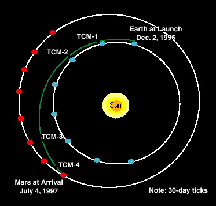
Mission Summary
Artist's Concept Of Lander And Microrover On MarsThe Mars Pathfinder Mission is the second launch in the Discovery Program, a NASA initiative for planetary missions with a maximum three year development cycle and a cost cap of $150M (FY92) for development. The Mars Pathfinder is managed for NASA by the Jet Propulsion Laboratory, California Institute of Technology, Pasadena, California.
The mission is primarily an engineering demonstration of key technologies and concepts for eventual use in future missions to Mars employing scientific landers. Pathfinder also delivers science instruments to the surface of Mars to investigate the structure of the martian atmosphere, surface meteorology, surface geology, form, and structure, and the elemental composition of martian rocks and soil. In addition a free-ranging surface rover is deployed to conduct technology experiments and to serve as an instrument deployment mechanism.
Mission Description
The flight system is launched on a Delta II-7925 launch vehicle which includes a payload assist module (PAM)-D upper stage, from the Cape Canaveral Air Station. The mission launch window is a 29-day period beginning on December 2, 1996.After launch, the spacecraft requires 6 to 7 months to reach Mars, depending upon the exact launch date. During this phase, a series of four trajectory correction maneuvers (TCMs) are performed, in order to fine tune the flight path. Tracking, telemetry, and command operations with the spacecraft are conducted using the giant dish antennas of the NASA/JPL Deep Space Network (DSN). Upon arrival at Mars on July 4, 1997, the spacecraft will enter the martian atmosphere, and then deploy the parachute, rocket braking system, and air bag system for a soft, upright landing. At this point the primary data-taking phase begins, and continues for 30 martian days or sols (24.6 hours).
During this time, the microrover is deployed and operated for at least 7 sols. If the lander and rover continue to perform well at the end of this period, an extended mission may continue for up to one martian year for the lander, and the microrover for up to 30 sols.
Major Mission Characteristics
- Launch Period
- December 2 - 31, 1996
- Launch Vehicle
- Delta II - 7925
- Trajectory
- 6-7 Months
- Primary Mission
- Land On Mars - July 4, 1997
- Complete Surface Mission
- August 1997
- End Of Project
- September 1998
For more information: http://marsprogram.jpl.nasa.gov



